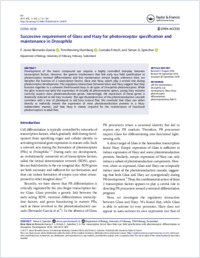Successive requirement of Glass and Hazy for photoreceptor specification and maintenance in Drosophila
- Bernardo-Garcia, F. Javier Department of Biology, University of Fribourg, Fribourg, Switzerland
- Humberg, Tim-Henning Department of Biology, University of Fribourg, Fribourg, Switzerland
- Fritsch, Cornelia Department of Biology, University of Fribourg, Fribourg, Switzerland
- Sprecher, Simon G. Department of Biology, University of Fribourg, Fribourg, Switzerland
-
03.04.2017
Published in:
- Fly. - 2017, vol. 11, no. 2, p. 112–120
English
Development of the insect compound eye requires a highly controlled interplay between transcription factors. However, the genetic mechanisms that link early eye field specification to photoreceptor terminal differentiation and fate maintenance remain largely unknown. Here, we decipher the function of 2 transcription factors, Glass and Hazy, which play a central role during photoreceptor development. The regulatory interactions between Glass and Hazy suggest that they function together in a coherent feed-forward loop in all types of Drosophila photoreceptors. While the glass mutant eye lacks the expression of virtually all photoreceptor genes, young hazy mutants correctly express most phototransduction genes. Interestingly, the expression of these genes is drastically reduced in old hazy mutants. This age-dependent loss of the phototransduction cascade correlates with a loss of phototaxis in old hazy mutant flies. We conclude that Glass can either directly or indirectly initiate the expression of most phototransduction proteins in a Hazy-independent manner, and that Hazy is mainly required for the maintenance of functional photoreceptors in adult flies.
- Faculty
- Faculté des sciences et de médecine
- Department
- Département de Biologie
- Language
-
- English
- Classification
- Biological sciences
- License
-
License undefined
- Identifiers
-
- RERO DOC 288544
- DOI 10.1080/19336934.2016.1244591
- Persistent URL
- https://folia.unifr.ch/unifr/documents/305372
Statistics
Document views: 81
File downloads:
- pdf: 185
